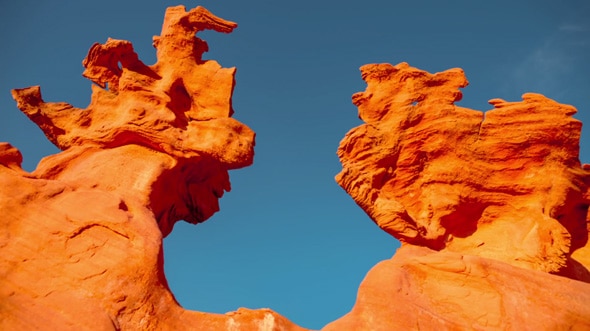Create a free profile to get unlimited access to exclusive videos, sweepstakes, and more!
Petrified

Panicked with last minute preparations for the holidays? Gift wrap everywhere, desiccated pine needles covering your floor, and the in-laws due any minute?
I have the perfect stress-reducer for you: Stop what youâre doing and watch this time-lapse video, âPetrified Life.â Itâll help. A lot.
[Please engage SOP: Make it full screen, and turn the volume up.]
Holy wow. Iâve been out to the American southwest a few times, and the formations there are stunning; layered sedimentary rocks deposited over the eons by inland seas have eroded away, leaving spectacular and bizarre structures seemingly painted by the forces of nature. The time-lapse provides a sense of the deep, deep time of these rocks, patiently counting out the millennia, coupled with the fleeting, almost hurried feeling of the clouds whipping by.
Thereâs so much to see, but I want to point out three moments in particular. Anneliese Possberg, the photographer, sent me a note about a peculiar green glow in the sky at about the 3:15 mark. You can see it low in the sky. My first thought was an aurora, but then I realized (from the starsâ motions) the camera was facing east, not north. That made an aurora unlikely, which left airglow. Oxygen molecules in the upper atmosphere absorb energy from the Sun all day, then slowly release it at night as either red or green light, depending on the density of the molecules and other factors. Airglow is faint, but shows up in longer exposures away from city lights.
The second moment is at 3:50, when there is a sudden flash of light and puff of smoke. (I love how Possberg slowed the frame rate just at that moment, and the music accentuates it; I literally gasped out loud when I saw and heard it.) What she captured is a meteor, a small piece of cosmic debris burning up in our atmosphere. It left whatâs called a persistent train, a trail of ionized vapor from the solid bit of meteoroid as material blew off it. This vapor can glow for several minutes, and upper level winds blow it into twisting ethereal shapes. Iâve seen many examples in similar time-lapse videos.
Finally, thereâs a beautiful effect that comes right at the end of the video. Starting at 4:32, weâre looking east through the branches of a Joshua tree. The sky lightens, and then a bright light rises â¦Â but itâs not the Sun, itâs the Moon! The thin crescent Moon, in fact, the phase just a few days before new. Just as it clears the tree you can see the dark part of the lunar surface, softly lit by light reflected from the Earth. This is called Earthshine, and is enough illumination that you can see many of the giant impact features on the Moon. But as it rises and the camera settings compensate for the increased brightness of the sky, the faint Earthshine fades away, leaving just the lovely thumbnail Moon moving up into the sky.
Spectacular. Given this video, and Possbergâs earlier âArctic Lightscapes,â Iâm eager to see more of these astonishing time-lapse efforts by her.


























